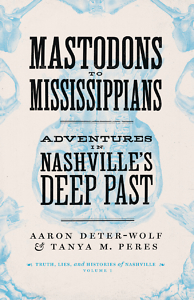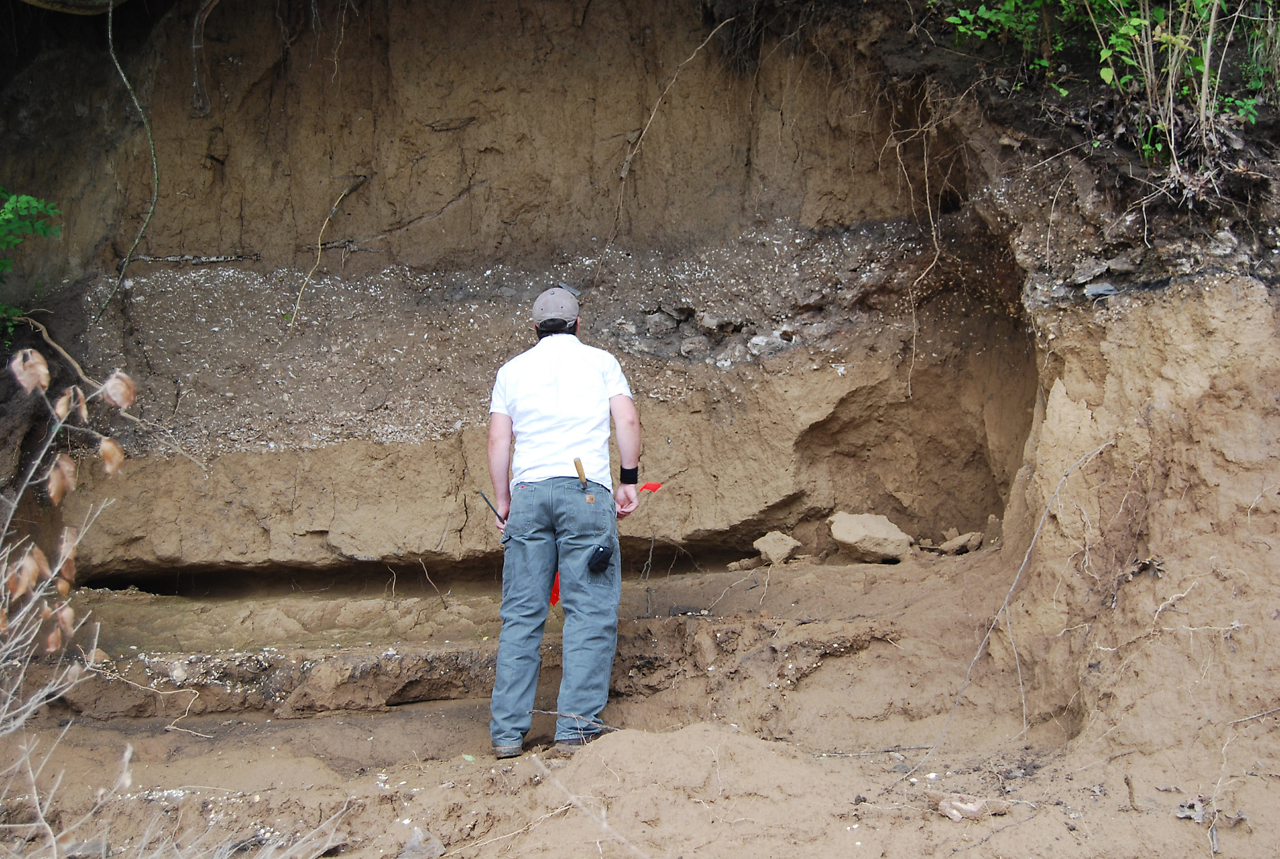Archaic Snailfishing in Nashville
Book Excerpt: Mastodons to Mississippians: Adventures in Nashville’s Deep Past
All but three of the shell midden sites in Middle Tennessee are located at river confluences, where the Cumberland or Harpeth are fed by one of their larger tributaries. As those waterways enter the Cumberland, they deposit their bedloads, the mix of sediment and gravels that accumulates along their path. Before the natural character of the river was changed in the twentieth century by channel dredging and dam construction, these confluences were marked by shallow, rocky shoals.

Shoals make up the natural habitats of many species of freshwater shellfish, including both river mussels and aquatic snails. Freshwater mussels of the biological family Unionidae are found worldwide, but are especially diverse in the rivers of Tennessee and Kentucky. More than 150 unionid taxa are recorded in Tennessee, with 85 species identified in the Cumberland River basin. The many small, freshwater snails found in streams and rivers of Middle Tennessee are sometimes called “periwinkle” or “screw shells,” and most often belong to the family Pleuroceridae. Pleurocerids are found only in Eastern North America, and include more than 140 species. In our archaeological samples, these snails range in length from about 0.17-1.6 inches. At Tanya’s field site, one particular species of river snail stood out as being the most common, making up more than 80 percent of the total excavated gastropod remains. Today that species, the armored rocksnail (Lithasia armigera), only lives in two areas outside of the Ohio River Valley, and in Tennessee is found only in the Cumberland River.
Freshwater shellfish presented a plentiful and easily accessible food source for ancient Native American inhabitants of Middle Tennessee. However, it was not until relatively recently that archaeologists recognized the possible long-term importance of these species to ancient diets. In the 1940s, archaeologists with the University of Tennessee and Works Progress Administration conducted excavations at the Eva site, a large shell midden on the Tennessee River in Benton County. The investigators noted that while many remains of deer and other mammals were present above and below the shell midden, bones from those animals were virtually absent within the shell layers. To explain these shifts, archaeologists suggested that severe droughts during the Archaic period had crashed the white-tailed deer population and caused game shortages. They postulated that in order to avoid starvation, ancient Native Americans turned to the shellfish beds made newly accessible by drought-reduced river levels. After the droughts passed, the river levels rose, deer populations rebounded, and people returned to their preferred food source. Over the next several decades, a similar consensus developed among many American archaeologists: that freshwater shellfish were a marginal food source, consumed during times of environmental stress or when large game were not available. These attitudes were not entirely new, but rather grounded in several centuries of historical European and Euro-american biases that considered Native American foraging, and shellfishing in particular, as being inherently “primitive” activities compared to hunting game and farming.

It is relatively easy for modern observers to embrace the idea of eating river mussels. A meal of freshwater snail is less familiar, and gastropod remains have been given especially short shrift in archaeological discussions. Well-researched shell midden sites from other areas, like those along Kentucky’s Green River, are composed mainly of bivalve remains. Prior to our 2010 survey, it was assumed that the Cumberland River sites were also made up mostly of river mussels. Our research in Davidson and Cheatham counties shows the opposite: that gastropods are overwhelmingly more abundant than bivalves in the Nashville-area shell middens.
The sheer number of aquatic snails at some of the Cumberland River sites is staggering. At Tanya’s field school site, for example, we found that archaeological deposits of densely packed gastropod remains measured up to 5 feet thick in some areas. Combining the results of test excavations with data from the auger survey and a ground-penetrating radar study, we were able to estimate the site-wide number of gastropods at more than 360 million individuals. That does not include the portion of the site destroyed by the 2010 flood or by historical riverbank erosion. A cursory archaeological study of the same site done in 1988 found that, at that time, the shell midden extended over an additional acre. By our estimates, that portion of the site, now eroded into the Cumberland, probably included more than 370 million additional snail shells.
The quantity of freshwater snails found at Cumberland River shell middens was not deposited overnight, or even over several decades. Radiocarbon samples collected by Tanya and her students show that, at their site, the shell deposit formed over a period of more than 2,000 years, between approximately 4900 and 2600 BC. Remarkably, there is no evidence of any interruption within the shell layers. If deposition of shellfish remains had stopped for an appreciable amount of time, plant growth and natural soil formation would have created a distinct layer, visible in the archaeological record as a band of soil stretching across the shell midden. No such soils are present at any of the shell midden sites we have examined along the Cumberland. This tells us that Archaic period snailfishing in the Nashville area was not a makeshift reaction to an environmental crisis. Instead, it was a sustainable lifeway continually practiced, at least in one case, over some 80 generations.
 Ceramics and pottery were not part of the Archaic toolkit when the Cumberland River shell sites were occupied. The oldest pottery in the Southeastern United States was made as early as 2500 BC in coastal communities of what is today Georgia, South Carolina, and northern Florida. That technology did not immediately gain widespread adoption outside those areas, and ceramics would not become standard in Middle Tennessee until after AD 200. Instead, most Archaic communities along the Cumberland relied on the same traditional technologies to carry, process, cook, store, and serve food which they had for millennia, including woven fiber or cane baskets, hide or skin bags, and wooden bowls or plates. These technologies decompose relatively quickly, and archaeological evidence for their use therefore comes mostly from sites with extraordinary preservation such as peat bogs and dry caves. Sadly, there are few intact sites like this in the American Southeast, fewer in Tennessee, and almost none in Nashville.
Ceramics and pottery were not part of the Archaic toolkit when the Cumberland River shell sites were occupied. The oldest pottery in the Southeastern United States was made as early as 2500 BC in coastal communities of what is today Georgia, South Carolina, and northern Florida. That technology did not immediately gain widespread adoption outside those areas, and ceramics would not become standard in Middle Tennessee until after AD 200. Instead, most Archaic communities along the Cumberland relied on the same traditional technologies to carry, process, cook, store, and serve food which they had for millennia, including woven fiber or cane baskets, hide or skin bags, and wooden bowls or plates. These technologies decompose relatively quickly, and archaeological evidence for their use therefore comes mostly from sites with extraordinary preservation such as peat bogs and dry caves. Sadly, there are few intact sites like this in the American Southeast, fewer in Tennessee, and almost none in Nashville.
Because perishable Archaic technologies have not survived archaeologically, the specifics of shellfish cooking along the Cumberland River remain unclear. Preparations may have included simmering them by adding hot rocks to skin water bags, cooking by direct heat on stones above a hearth, or roasting in clay ovens or ash beds. Once cooked, snails could have been extracted from their shells using carved wooden toothpicks, a type of artifact that rarely survives in the archaeological record, while mussels would have been easily pried open with stone tools. Many of the snail remains from Tanya’s field site exhibit single, small punctures in their outer whorls. These are not marks left by any of the snail’s natural predators, and we suspect they may instead have been made by people using stone or wooden tools to help remove the meat from the shells after cooking.
When considering ancient, pre-agricultural lifeways, it’s tempting to reduce food to simply a search for calories. According to this logic, successful foraging brings in more calories than are expended in the search for food. In terms of energy, deer meat contains twice as many calories as freshwater gastropods, and therefore would seem to be a preferential food source. But, as foodies know, meals are not just about calories. Freshwater snails provide higher amounts of calcium and iron than deer, while also being high in phosphorus, sodium, and potassium. People in the past lacked scientific laboratories in which to quantify the specific dietary benefits of their different foodstuffs, and instead created their foodways through generations of experimentation and familiarity with their local environment. By harvesting large quantities of snail remains, Archaic communities along the Cumberland were able to obtain essential nutrients — many of which are important for pregnant and breastfeeding women — but which were not provided by the meat of deer or other terrestrial animals.
From Mastodons to Mississippians: Adventures in Nashville’s Deep Past, forthcoming from Vanderbilt University Press in August 2021. Copyright ©2021 Vanderbilt University Press. Reprinted with permission. All rights reserved.
Aaron Deter-Wolf is a prehistoric archaeologist for the Tennessee Division of Archaeology, and Tanya M. Peres is an associate professor in the Department of Anthropology at Florida State University. They are the editors of The Cumberland River Archaic of Middle Tennessee and Baking, Bourbon, and Black Drink: Foodways Archaeology in the Southeastern United States.








